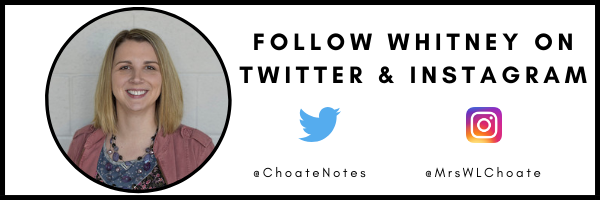In This Post:
- The difference between modifications and accommodations.
- Strategies to adjust your classroom activities & instruction to accommodate for diverse learners.
- A quick guide for modifications or accommodations based on common language found on IEPs and 504s.
Meeting the needs of diverse learners in today’s classrooms can be such a challenge. From at-risk, to gifted, to IEPs, 504s, and ELLs, it seems like every student has a label or some sort of acronym attached. It can be overwhelming for any educator to follow the paperwork that comes with these students. In this post, quick tips and tricks will be addressed to meet the needs of these diverse learners.
Modifications vs. Accommodations
First, one must understand the difference between a modification and an accommodation. Many times these are lumped together, but they are actually very different. A modification is changing what students learn, whereas an accommodation is changing how that student is learning. Typically, in many general education classrooms, accommodations are provided more often than modifications.
For example, a student may have an audiobook of the class textbook or novel as an accommodation, while another student may have a shorter or easier reading assignment from the rest of the class on the same topic.
There can also be overlap with these because the student who is reading at a lower level could also have that text read aloud; this student would then be getting both modifications and accommodations. Students with modifications are not necessarily expected to learn all the same material as their general education peers. These students have different learning outcomes.
We have to work together to help make all of our students successful. Click To TweetDon’t Reinvent the Wheel!
Just because a student learns a little differently doesn’t mean you have to spend hours creating new tasks, worksheets, or assignments for them. You can easily take most grade-level work and adapt it to the student’s specific modifications and accommodations.
Preferential Seating
A well-written accommodation will hopefully give specifics on what seating a student needs. Does this student need to be away from distractions or in front of the class? Does this student need to be by a window or near the teacher? When in doubt, ask the case manager for details.
For example, I had a middle school student that had severe ADHD and sporadically took medication. You never knew what you would get on a given day with this student. He had an accommodation for preferential seating away from distractions. For him, this typically meant in the back of the classroom where other students would be less likely to look at him when he was trying to gain attention.
I put painter’s tape on the floor in a box around his desk. He and I discussed the procedure, but in short, he was allowed to move around in that box by standing, walking, sitting in his desk, or moving however he needed to get his energy out. This helped him focus more on the classwork at hand and helped him be more engaged in learning in his general education class.
Study Guides
Many times, a student has an accommodation of being able to have study guides. If it’s not explicitly stated what that entails, you really have the freedom to do whatever you feel the student would benefit from. This could be copies of your notes or the study guide from the textbook. It could also be an outline, bulleted list of the topics, or broad questions with or without answers that will be on the assessment.
Note-taking
Sometimes students need to sit and absorb the information and can’t take notes like their peers. As the teacher, you could print out the slide presentation and white-out parts so the student then has fill in the blank notes.
You could also have another student take notes and make a copy of those. They are still following along and paying attention but not having to worry about getting everything down.
Modify or Shorten Tests and Assignments
There are a multitude of ways to adapt any kind of assessment. Hopefully, your student will have a well-written IEP or 504 plan which will state how you are to modify or shorten tests and assignments.
The easiest and most basic way is to remove one or more answers to multiple-choice questions. For matching questions, you could shorten the groupings. For example, instead of 10 words to match with definitions, split it in half either by drawing a line or, my personal favorite, highlight the words and definitions in two colors so the student knows which goes with which.
Many times for those who struggle with writing, you could have the student give the answers to short answer or essay questions orally, or allow the student to have short phrases instead of full essay responses.
For any test or assignment, if it is to be shortened, you could easily take off a certain number of questions. Many students in math, for example, could do the odd- or even-numbered problems instead of all the problems. Obviously, you want to make sure the most important questions and content are covered, but if you have two questions that cover the same content or standard, just give the student one of them.
For modifications, you can have different tests or assignments that cover the same content. This could be a task at a lower reading level or questions with a lower Depth of Knowledge. Many times, textbook companies have a lower level worksheet or test geared towards students who are not at the same level as their peers. I have even seen some textbook companies have lower difficulty tests for IEP and 504 students and a separate one for ELLs. Check into your textbook resources to see what they offer.
[scroll down to keep reading]

Expose Students to Content
It doesn’t hurt to expose a learner to something that they may not be able to grasp. A student may never take an Algebra class, but exposing them to basics can’t hurt.
Or in history, a student may be focused on more civics and life-skills based topics, but they still need to know about certain aspects of US history or the Holocaust. They may not get a full unit of those topics, but they will at least know they exist.
So Many More!
Have students do projects instead of worksheets or a presentation or podcast instead of a paper. Speak to the individual student’s strengths. There are so many ways to assess the content and standards. Your creativity is your only limitation.
Open Communication
The most important thing is to have an open line of communication between all the educators that work with a particular student. What works for your class could be the key for the success of that student in another classroom setting.
Maybe a student will require you to work more closely with one specific educator, such as the case manager or the student’s paraprofessional. As a colleague of mine once said, “You are not a classroom teacher. You are a school teacher. Your kids are everyone’s kids.”
We have to work together to help make all of our students successful.
Check out my Quick Guide to Modifications and Accommodations. Feel free to share it with other educators at your school.
ABOUT WHITNEY CHOATE
Whitney Choate is currently in her ninth year as a secondary special education teacher and is also an instructional technology specialist at Cape Central High School in Cape Girardeau, Missouri. She earned her Bachelor’s degree in Learning and Behavioral Disorders and a Master’s degree in Autism. She has a passion for teaching and mentoring learners of all ages. Whitney is also the co-host of the Tough Talk with Teachers Podcast.



